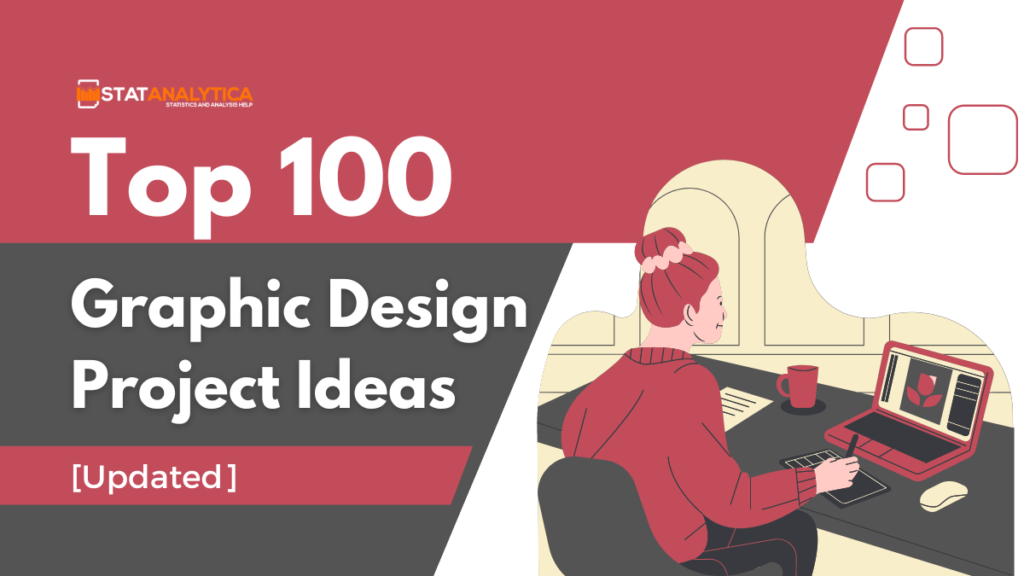Graphic design is a powerful and versatile medium that plays an important role in conveying messages, creating visual identities, and leaving a lasting impact. In the ever-evolving world of design, the exploration of graphic design project ideas is essential for staying relevant and innovative.
This blog will delve into various types of graphic design projects, considerations for successful execution, trendy ideas, challenges faced by designers, and tips to ensure a flourishing design journey.

What are the Types of Graphic Design Projects?
Table of Contents
Print Media
Print media remains a classic avenue for graphic designers to showcase their skills. Poster designs, brochure layouts, and business card creations offer a tangible and impactful way to communicate messages.
Each project requires a unique approach, blending creativity with functionality to captivate the audience.
Digital Media
In the digital age, graphic designers are tasked with creating eye-catching visuals for online platforms. Social media graphics, website designs, and app interfaces demand a keen understanding of user experience and the ability to adapt designs to varying screen sizes and resolutions.
Branding
Brand identity is a crucial aspect of any business, and graphic designers play a vital role in shaping it.
Logo designs, brand identity packages, and packaging designs contribute to establishing a brand’s visual language and fostering recognition.
Illustration
Illustrations bring a touch of artistry to graphic design projects. Whether through digital or hand-drawn illustrations, designers can create visually appealing and engaging content.
Infographic designs, in particular, allow for the effective communication of complex information in a visually accessible manner.
Considerations for Graphic Design Projects
- Target Audience
Understanding the demographics and preferences of the target audience is paramount. Tailoring designs to resonate with the intended viewers enhances the project’s effectiveness and ensures a more significant impact.
- Purpose and Goals
Identifying the purpose and goals of a graphic design project is essential. Whether the aim is to convey a specific message, create brand awareness, or provide information, a clear understanding of objectives guides the design process.
- Medium and Platform
Choosing the right tools and software is crucial for successful graphic design projects. Additionally, adapting designs for different platforms ensures a consistent and visually appealing presence across various mediums.
Top 100 Graphic Design Project Ideas
- Minimalist Poster Design
- Vintage-Inspired Logo Creation
- Social Media Quote Graphics
- Infographic on a Complex Topic
- Packaging Design for a New Product
- Business Card for a Creative Professional
- Magazine Cover Redesign
- Website Landing Page Revamp
- Album Cover Artwork
- T-shirt Graphic Design
- Custom Font Creation
- Environmental Awareness Poster
- Animated GIF for Social Media
- Food Menu Design for a Restaurant
- eBook Cover Illustration
- 3D Product Rendering
- Event Invitation Design
- App Interface Redesign
- Charity Campaign Graphics
- Car Wrap Design
- Product Label for Handmade Goods
- Interactive PDF Portfolio
- Icon Set for a Mobile App
- Sticker Designs for Brand Promotion
- Pattern Design for Textiles
- Social Media Banner Ads
- Digital Art Print Series
- Website Iconography Overhaul
- Annual Report Infographics
- Conceptual Product Mockup
- Educational Poster for Children
- Visual Brand Language Development
- Outdoor Billboard Advertisement
- Email Newsletter Template
- Health and Wellness eBook Layout
- Virtual Event Branding
- E-commerce Website Graphics
- Augmented Reality Filters
- Interactive Map Design
- Beer Label Artwork
- Conceptual Book Cover Design
- Real Estate Brochure
- Podcast Cover Art
- Dashboard UI Design
- Packaging for Sustainable Products
- Coffee Shop Menu Board
- Digital Magazine Layout
- Logo Animation for Video Intros
- Virtual Reality Environment Design
- Financial Report Data Visualization
- Influencer Media Kit Design
- Concept Car Advertisement
- Educational Game Graphics
- Neon Sign Design
- Recipe Card Illustration
- Inspirational Quote Wall Art
- Conceptual Product Packaging
- Environmental Awareness Campaign
- Logo Animation for Social Media
- Pop-Up Banner for Events
- Outdoor Apparel Catalog Layout
- Virtual Backgrounds for Video Calls
- Artistic Social Media Stories
- Editorial Illustration for a Newspaper
- Packaging for Limited Edition Items
- User Onboarding Graphics for Apps
- Annual Calendar Design
- Sustainable Packaging Redesign
- Custom Emojis for a Brand
- Interactive Website Navigation
- Abstract Mural Design
- Company Milestone Infographic
- Interactive Quiz Graphics
- Conceptual Movie Poster
- Fashion Lookbook Design
- Website Loading Animation
- Holiday Greeting Cards
- Personal Branding Collateral
- Conceptual Tech Gadget Mockup
- Custom Snapchat Geofilters
- Conceptual Album Art for a Band
- Beauty Product Packaging
- Art Exhibition Poster
- Animated Explainer Video Graphics
- 404 Error Page Redesign
- Social Media Contest Graphics
- Custom Avatars for a Community
- Virtual Trade Show Booth Design
- Science Fiction Book Cover
- Travel Postcard Series
- Packaging for Luxury Items
- Conceptual Smart Home Interface
- Concept Art for Video Games
- Skateboard Deck Design
- Food Truck Wrap Design
- Retro Video Game Graphics
- Financial Dashboard Infographic
- Conceptual Space Tourism Poster
- Animated Social Media Polls
- Branding for a Virtual Reality Experience
Tips for Successful Graphic Design Projects
Achieving success in graphic design projects involves a combination of creativity, technical skill, and effective project management. Here are some essential tips to ensure your graphic design projects thrive:
- Understand the Project Requirements:
- Begin by thoroughly understanding the client’s needs and project goals.
- Clarify expectations, deadlines, and any specific preferences the client may have.
- Know Your Audience:
- Tailor your design to the target audience. Understand their preferences, demographics, and behavior to create more impactful visuals.
- Research and Gather Inspiration:
- Conduct research to stay updated on design trends, industry standards, and competitors.
- Collect inspiration from various sources to spark creativity and bring fresh ideas to your projects.
- Create a Clear Design Brief:
- Develop a detailed design brief that outlines project objectives, target audience, key messages, and any specific requirements.
- A clear brief helps you and the client stay aligned throughout the design process.
- Effective Communication:
- Maintain open and transparent communication with clients. Regular updates, check-ins, and feedback sessions ensure that everyone is on the same page.
- Time Management:
- Create a realistic project timeline with well-defined milestones.
- Prioritize tasks, set deadlines, and allocate sufficient time for revisions and unforeseen challenges.
- Collaborate and Seek Feedback:
- Collaborate with team members or clients to enhance the creative process.
- Actively seek feedback and be open to constructive criticism to refine your designs.
- Embrace Constructive Criticism:
- View feedback as an opportunity for improvement. Analyze critiques objectively and use them to enhance your design skills.
- Stay Consistent with Branding:
- When working on branding projects, maintain consistency across all elements, including colors, fonts, and visual style.
- Ensure the design aligns with the established brand identity and guidelines.
- Test Across Platforms:
- Test your designs on different devices and platforms to ensure they are visually appealing and functional across various screen sizes and resolutions.
- Keep It Simple:
- Strive for simplicity, especially in communication design. Clear and straightforward visuals are often more effective in conveying messages.
- Stay Updated on Tools and Software:
- Familiarize yourself with the latest design tools and software to stay efficient and competitive in the field.
- Continual Learning:
- Graphic design is an ever-evolving field. Invest time in continuous learning to stay informed about new trends, techniques, and technologies.
- Build a Strong Portfolio:
- Showcase your best work in a portfolio that reflects your diverse skills and style.
- Update your portfolio regularly to showcase your latest and most relevant projects.
- Network and Connect:
- Engage with other designers, attend industry events, and participate in online communities.
- Networking can lead to collaboration opportunities and provide valuable insights into industry trends.
Conclusion
Exploring graphic design project ideas is an exhilarating journey filled with creative possibilities. From traditional print media to cutting-edge digital designs, graphic designers play a crucial role in shaping visual experiences.
By considering the target audience, purpose, and medium, embracing trendy ideas, overcoming challenges, and following essential tips, designers can embark on a path of continuous growth and innovation in the dynamic world of graphic design.


